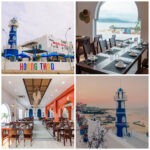10 Tips On How To Create Better Black & White Images, Shop Womens Black & White Collection
Black and white was once the only means we had to communicate, photographically. That was long before most of us got involved with it. But for some of us, B&W is how we started off in photography, and how we saw our images in print. But since the beginning of photography, black and white has been a very romantic medium. That romance continues to this day, with black and white easier and simpler to do than ever. And yet, for some, it’s just as complicated and difficult as ever. Perhaps this will give you some ideas to advance your black and white photography.
Đang xem: 10 tips on how to create better black & white images
Editor”s Note: This is a guest blogpost by Moose Peterson
Watch B&W Movies like Casa Blanca
I’m a huge fan of B&W movies from the 40s and 50s! I watch the plot, but even more so, I watch the lighting! They couldn’t use color to pull our attention around; they had to light to do that, using shades to tell their story. Mystery, death, love, hate, jealousy—they said them all with light! You can watch and learn a lot about B&W photography from these old movies. Keep in mind that everyone watches them. The public has certain preconceived visual concepts because of them. Learn them, explore them, and exploit them, and you can vastly improve your B&W photography!
Contrast is Your Friend!

Traditionally, black and white photography has been a contrasty medium. In color photography, big contrast is often discouraged. In the days of film, we often would attach a red filter when shooting black and white, just to increase the contrast. In this example, because of the large boulder, the bald skies of Alabama Hills go very dark, thus making the boulder visibly pop. Looking under the boulder, you can see the heavy shadow, telling you it’s a contrasty condition.
Flat Light has Lots to Offer

And the exact opposite is true as well! Flat light, or light which has no giant range of exposure, can make for dramatic B&W images. Typically, though, this requires that you look at the elements, and find one or more deep blacks that grab the eye. In this case, the falling snow is flattening out the light, though the snow on the ground sets the stage. The wet, black road in the center of the frame takes the eye through the image, and then the speckles of black bring the eye back down. Standing there, you wouldn’t have thought there was a photo, and that’s because of the flat light.
Black Makes White Brighter

This is a favorite trick of mine: making the darks darker so the lights appear brighter. By association—and nothing else—when we make darks go darker, the mind just assumes the other elements have to be brighter, even though in reality they are not. This downpour over Bridgeport Reservoir is an example of that. In this case, I knew what was possible in the darkroom that would pull that black down, making that small microburst really pop. This is not what I saw standing there. It was a pretty even gray sky. The only difference is that the microburst was reflecting light, and the background was not. That’s all that was required to make it pop in post.
Xem thêm: Vé Xe Hà Nội Móng Cái Giường Nằm Ka Long Móng Cái Mỹ Đình, Xe Giường Nằm Ka Long Móng Cái Mỹ Đình
Graphics Make for Bigger Drama

I just love vanishing lines! When you can include those in any B&W photo, you have a visually powerful image. In this case, with this little rail station in Upper NY, the architecture lends itself perfectly to the drama of B&W. The long, narrow construction, the gingerbread pattern, and the bright rails leading off into the distance take the eye to the stormy skies, which bring you right back to the front of the station. Because it’s by the roof line, the bright spot in the sky helps with the competing pattern of the gingerbread.
Gotta Have a Clean White and a Clean Black

If there is one thing you need in a B&W photo, if nothing else, it is a clean white and a clean black. Is this a rule? No, it is merely a starting point in your thinking, capturing and finishing a photo. Without a clean black and a clean white, you have what is called a “muddy” image. This means you simply have a bunch of shades of gray. In this photo of the Bodie Lighthouse, the only clean white is the post of light (and that was created in post), and the only clean black is the roof. But that’s enough for you to notice all of the texture in the image. If your B&W images just don’t seem to have real zing, it could simply be a case of no clean blacks and no clean whites.
Xem thêm: Nhà Xe Khách Đức Phúc – Hãng Xe Khách Đức Phúc
Exposure is Your Friend

“Seeing” (thinking) in B&W is a very common difficulty for photographers. This stands to reason, since we live in a color world. Many B&W images are around you if you just think underexposure. This shot, taken at Cliff House in San Francisco, was an off-the-hip shot as we were walking in to breakfast. It was basically a bright morning, with the storm quickly heading east. I saw that great cloud shape in the sky, and knew I wanted the shot. If I exposed normally, the sky would have been blown out and the sand a medium gray. But by underexposing 2.5 stops, I pulled the sky to gray, the beach went black, and the surf stayed white, leading the eye through the frame.
Filters Make it Easier

In the game of black and white photography, filters still make a world of difference! The polarizer can be used, unconventionally, to darken the sky, which in B&W creates big-time black drama. The split grad can be used for the same purpose, as you see in this photo of Ausable Chasm in NY. The mist from the falls was the photo, but to bring this out, its brightness needed to be set against something dark. By using a .9 (3 stop) split grad turned severely to the left, darkening the left corner, the mist could visually pop. There is no doubt that you have to think B&W when you do this, because you wouldn’t have taken the photo if the end results were to be in color. How do you develop an eye to see this? You do it a lot, and learn from you successes as well as your failures. If you don’t have failures, you know you’re not trying!
Silver Efex Pro

Polycontrast in a slider—that’s how I think of Nik’s Silver Efex Pro 2! This is the ONLY software I use to create my B&W images. Why? It’s so bloody simple, effective and beautiful. And here’s the secret: the Structure! It’s a slider in the program, and when taken to the range of the 80s, it works magic like nothing else! There isn’t a photo here that hasn’t been kissed by the beauty of Structure to make the B&W magic happen. And here’s the thing—until you own Silver Efex Pro 2 and you use Structure, you have no way of knowing when you’re shooting what will or won’t make a great photo. If there is ONE trick, technique, tool—anything I can recommend to you to improve your black and white photography, this is it!
Levels & Curves!

Small subtleties add up to big drama! Every one of these photos has seen Photoshop CS6, and that was to add small subtleties you can’t do otherwise. It could be the slight darkening of a cloud to make the cloud next to it brighter, using Curves and the Brush. It could be a slight move in Levels to push some blacks to deep black. You might need to lighten a God beam, or darken the side of a rock. These small, fine tunings that we can’t do any other way, are a must in making the gorgeous black and white photo!






Bình luận